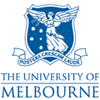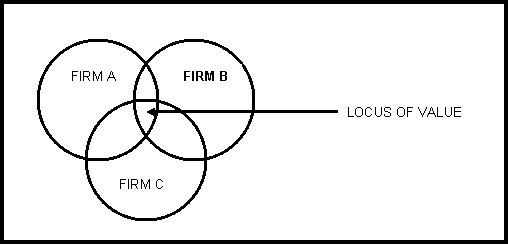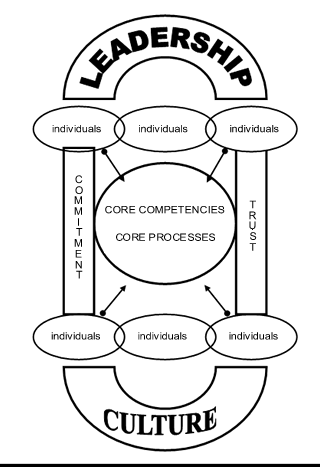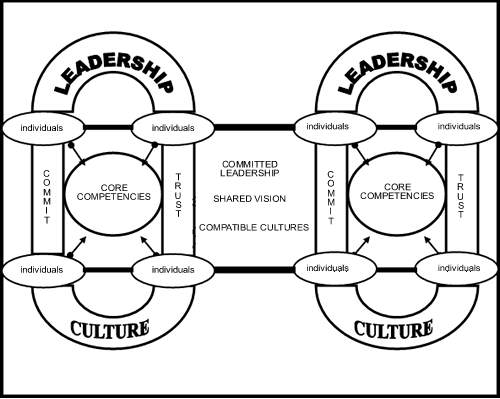|
|
|||

Department of Agriculture and Food Systems
|
||||
|
||||
|
|
|||

Department of Agriculture and Food Systems
|
||||
|
||||

|
|
Agribusiness Perspectives Papers 2004Paper 62 The Learning Organization: a new imperative for Australian Agribusiness?A. J. Dunne AbstractSince the mid 1980s Australian agribusiness has been subjected to continuous structural change as individual firms have adjusted to the forces of deregulation, advances in technology and dynamic consumer expectations. Evidence of this structural change can be found in the consolidation that has occurred at all stages of the agribusiness value chain and the emergence of partnerships, alliances and networks as the predominant strategic option among these firms. This paper examines the role that organizational learning can play in assisting both individual firms and the value chains to which they belong adjust to these changes in their competitive environment. Drawing on the literature, three checklists have been constructed that enable executives of agribusiness firms to assess their firms' ‘readiness to learn' and their capacity to develop a learning agribusiness within a learning agribusiness chain. In doing so, the author raises the question – do Australian agribusiness firms have any option but to become learning organizations if they are to compete successfully? IntroductionTwenty years ago, the newly elected Labour government under Prime Minister Bob Hawke, implemented a program of micro and macro economic reform that opened up the Australian economy to the world. As Kelly (2003) points out these reforms ‘symbolized the end of certainty and our entry into a globalised age of uncertainty', but have resulted in an Australia that ‘is more outward looking, tolerant and competitive'. Many of these reforms such as the floating of the exchange rate, the deregulation of the financial system, the demise of statutory marketing authorities and the introduction of national competition policy, have had a direct impact on the structure and operation of the agribusiness sector. The most visible sign of the restructuring has been the consolidation of firms at each stage of the agribusiness value chain from input suppliers, to farms, processors and retailers. For example, Martin et al (2000) report that regardless of commodity grouping, agricultural production is concentrated among larger firms. The top quartile of farms produces 60-90 per cent of the value of production, achieves most of the productivity gains and captures most of the sector's profits. In addition to consolidation, firms within the agribusiness sector are changing the ways in which they operate and interact with each other. This change is illustrated by the continual reference to the importance of establishing strategic partnerships, alliances and networks in the literature (Dunne 2001), at conferences[1], in government programs[2] and in the press (Bachelard 2003; Bromby 2003). These competitive strategies of consolidation and alliance building are those being adopted by firms throughout the world as management struggle to cope with the complexities of what Limerick et al (2000) refer to as the post-corporate era but perhaps more aptly described by Handy (1989) as ‘the age of unreason'. The success of both strategies is dependent upon the individual firms and their value chain partners being able to learn from their past experiences and as a consequence adapt to their changing business environment. Senge (1992) postulates that the most successful firms in the future will be learning organizations – organizations that have the ability to learn faster than their competitors: blockquoteThe organizations that will truly excel in the future will be the organizations that discover how to tap people's commitment and capacity to learn at all levels of the organization (p.4)Argyris and Schon (1996) share this view of the importance of organizational-wide involvement to the continued success of the organization: blockquoteOrganizational success, however defined, is seen as depending on the organization's ability to see things in new ways, gain new understandings, and produce new patterns of behaviour – all on a continuing basis and in a way that engages the organization as a whole (p.xix).Consequently, it would appear prudent that leaders of agribusiness firms become aware of the process of organizational learning, and what is involved in building a learning organization, if they are to be in a position to evaluate the significance of these concepts to their individual firms in the context of their evolving competitive environment. The purpose of this paper is to review the literature on organizational learning so as to identify the key elements of individual and collective learning. A discussion of the management issues associated with learning organizations, particularly within a framework of value chain partnerships will then follow. How do organizations learn?Nevis et al. (1995) describe organizational learning as the capacity or processes within an organization that allow it to improve its performance based on experience. Organizations learn via the individuals within a firm and their interactions with colleagues both internal and external to the organization (Argyris & Schon 1996; Senge 1992). Kim (1993) observes that all organizations learn whether they consciously choose to or not. Therefore what becomes important to a firm, in a strategic sense, is not only the rate of learning, what is learnt, and by whom, but also how information is harnessed, transformed and transferred internally as knowledge. The fact that some firms continue to thrive during periods of economic uncertainty while others decline is a clear indication that individual firms vary in their ability to learn and adapt (Spekman, Spear & Kamauft 2002). Given this, from an organization's perspective three key managerial factors emerge:
Individual learningLearning is a knowledge-building process by which individuals acquire the ability to act and which involves both operational (the ‘know how') and conceptual (the ‘know why') learning that is based on the interpretation of feedback from prior action (Robinson 2001; Sveiby 2001). This model of individual learning is grounded in experiential learning theory that is best demonstrated by Kolb's Learning Cycle (Figure 1). According to the Kolb model, learning is stimulated when an individual observes an unintended consequence resulting from their existing practices or behaviours. Argyris and Schon (1996) refer to an individual's existing practices and behaviours as their ‘theories-in-action'. The individual responds by reflecting on these observations against a background of prior experience and if it is deemed necessary, designs corrections to their practices or behaviours. The modified ‘theories-in action' are then implemented and the outcomes observed. Hence the learning cycle is completed until the next unintended consequence is observed. Argyris and Schon call this type of learning ‘instrumental learning' or ‘single-loop' learning because it seeks to improve the task performance but leaves the values and criteria associated with the measures of such improvement unaltered. What features of the world an individual sees, what concepts are used to interpret them, what values are embraced in the process and what range of behaviours are adopted depends upon how an individual views the world or what Senge (1992) terms an individual's mental models. According to the concept of cognitive culture these mental models or neural nets are shaped by our environment and reinforced by our experience, so once established they are difficult to alter (Lakomski 2001). The inflexibility of our mental models offers an explanation of why an individual may persist with a current mode of behaviour in the face of evidence that such behaviour is inappropriate. Figure 1: Kolb's Learning Cycle (Kolb 1984).
Since our mental models are the basis of our conceptual frameworks and operational routines we will only start to question their validity in the face of persistent and potentially threatening outcomes from our current ‘theories-in-action' (Kim 1993). Argyris and Schon refer to this process of changing our untested assumptions that we make about people and situations ‘double-loop' learning. What are the implications for management of an organization that arise out of this overview of how an individual learns? Schein (2002) offers us some insights when discussing why very few learning organizations exist. Resistance to learning, especially ‘double-loop' learning, is due to what Schein calls learning anxiety – anxiety associated with being confronted with the need to learn something new but being afraid of not being able to achieve it. Countering learning anxiety is survival anxiety – anxiety associated with the need to survive. Schein concludes that individuals will learn only when survival anxiety exceeds learning anxiety. Further Schein argues that since learning involves the freedom to experiment and the application of individual creativity, an organizational culture that doesn't accommodate, encourage and reward these activities is counterproductive. In summary an organization that promotes individual learning will:
Shared learning within an organizationThe old adage ‘the most valuable resource of an organization is its people' is given new credibility through what has become known as the ‘knowledge-based view of the firm' (Foss 1996; Grant 1996; Nonaka 1991). According to Stata (1989), knowledge and the ability to use it effectively is perhaps the most strategically important of the firm's resources and may become its only source of sustainable competitive advantage. Sveiby (2001) defines knowledge as the capacity to act. Knowledge is a result of learning where data and information are transformed and utilized by individuals. Knowledge can be either explicit – knowledge that describes what an organization does and can be codified, for example, as policy manuals and operating procedures, or tacit – knowledge that underpins the behavioural aspects of what an organization does and thereby constitutes the organization's culture The ability of an organization to learn depends on its ‘learning orientation' (its values and practices that determine where learning takes place and what is learnt) and its ‘facilitating factors' (the structures and processes that influence how difficult or easy it is for learning to take place) (Appelbaum & Reichart 1997). When individuals join an organization, they are expected to act within the standard operating procedures and behavioural norms that have developed to minimize embarrassment or threatening behaviour and thereby promote organizational harmony and stability. These operational procedures and behavioural norms, an organization's theories-in-use, are based on shared mental models and experiences of past and present members of the organization and in general terms represent its organizational memory and culture (Kim 1993; Schein 1992). The degree of alignment between the mental model held by an individual and the shared mental model of the organization will influence an individual's commitment to the organization and their willingness to collaborate with colleagues. Senge (1992) claims that successful organizational learning is based on team learning and the presence of a shared vision. According to Senge, the synergy of effective teams taps the talents of individuals, develops operational trust and fosters learning within other groups in the organization. Further, the building of a shared vision fosters commitment to the organization and generates the excitement, energy and focus that are so necessary for innovation to occur. In the previous section it was established that individual learning is a cycle of conceptual and operational learning that informs and is informed by the individual's mental model. The process of organizational learning is similar. The organization's shared mental models inform the standard operating procedures and norms of behaviour adopted by the organization. In turn, the organization's shared mental models are informed by the outcomes of its theories-in-action. The adaptive and generative capacity of an organization depends on its ability to recognize that its current theories-in-action are inadequate and to develop new shared mental models that are more attuned to its operational environment – a process of organizational double-loop learning that most organizations find difficult: blockquoteEvidence is mounting that real change does not begin until the organization experiences some real threat that in some way dashes its expectations and hopes (Schein 2002 p.105).Schein (1992) claims that the culture of an organization is the prime source of resistance to change. He defines the culture of a group as: blockquoteA pattern of shared basic assumptions that a group learnt as it solved its problems of external adaptation and internal integration, that has worked well enough to be considered valid and therefore be taught to new members as the correct way to perceive, think and feel in relation to those problems (p.12).If the survival of a group is threatened because its culture is inappropriate then Schein advocates that it is the responsibility of the leadership of the group to recognize the situation and do something about it. Two interesting aspects of Schein's definition of culture and its interdependency with leadership are the inferences that:
As Lakomski (2001) points out, these differences in culture across an organization are responsible for the different perceptions that exist concerning the nature of threats to the organization, what are the appropriate responses to make and the appropriate rate at which change should occur. The proposition that leadership is an organization-wide responsibility is well supported in the change management literature (Crowther et al. 2002; Hamel, 2000; Kotter 1996; Limerick et al. 2000). Although leadership is not the exclusive role of senior executives, leadership initiatives regardless of their origins within the organization ultimately have to be endorsed by those in positions of power. Therefore if an organization wishes to maximize organizational learning it has to develop an internal climate that not only motivates individuals to maximize their own learning but also encourages them to collaborate with their colleagues. The Focus-Will- Capability (F-W-C) Performance System developed by Smith and Tosey (1999) provides a useful framework in which to measure an organization's success in meeting these challenges (Figure 2). Figure 2: The Focus-Will-Capability Performance System |
 |
Collins et al. (2002) define the ‘locus of value' as the increased capacity of the partners to create consumer value through maximizing opportunities for shared learning. They conclude:
blockquoteWhen the results of this shared learning add to the core intangibles of each firm – the processes, systems, databases, and structures – a learning chain exists, and value is created that could neither be created in any other way, nor easily duplicated by firms whose relationships are not configured so as to create a locus of value (p. 320).Events post September 11 2001, should have dispelled any lingering doubts about the emergence of the post-corporate era – an era that will be defined by rapid discontinuous change in the global competitive environment. The question is – how are Australian agribusiness firms positioned to compete and prosper in such an environment?
Academics and consultants approach the study of how organizations adapt to change in their operating environment from a number of different directions depending upon their disciplinary focus. For example, the study of the changing nature of business organizations can be viewed from the perspective of strategic management (Doz & Hamel 1998; Hamel 2000), change management (Handy 1989; Kotter 1996; Limerick et al 2000) or organizational learning (Argyris & Schon 1996; Schein 1992; Senge 1992). Irrespective of the disciplinary approach taken, the common theme that emerges is that successful organizations of the future will effectively harness the intellectual capacity of their employees and develop the capacity to leverage their intellectual capital off that of strategically selected partners. The question is – have Australian agribusiness firms the prerequisites that are necessary to build their intellectual capacity?
The prototype of the post-industrial agribusiness (Figure 4) is the learning agribusiness whose strategic assets are deeply embedded in its intangible assets:

The development of an organization's intangible assets – organizational learning, is dependent upon creating an internal environment that enhances the capabilities for learning of the individual and the organization as a whole. The nature of the internal environment of an organization is determined by its culture and leadership (Schein 1992; Senge 1992).
The leadership team can assess its organization's ‘readiness to learn' by answering the following questions:
A key role of leadership in a learning organization is building trust among individuals and commitment to the organization. Agribusiness executives can quickly establish if they have the common elements of leadership that emerge from the literature as essential for organizational learning to occur by reflecting on the following points:
These simple checklists serve to build a profile of the current state of the organization's strengths and weaknesses as a learning agribusiness.
When the concept of a learning agribusiness is extended to that of a learning agribusiness chain (Figure 5), it is the same processes of building trust and commitment within organizations that are required to facilitate inter-organizational learning – a shared vision, similar cultures, and committed leadership that are reinforced by multiple personal relationships between the chain partners.

Again, based on the literature a simple checklist to evaluate the agribusiness chain's ‘readiness to learn' can be constructed:
This paper has presented a review of the literature that covers the concept of a learning organization and the nature of organizational learning. This review identifies that successful organizations in the twenty-first century will be those that develop the ability to learn faster and better than their competitors. Further the literature identifies successful organizations as having the capability to form and sustain partnerships that synergistically enhance their value creation competencies.
Drawing on the literature three checklists have been constructed that enable the executives of agribusiness firms to assess their firm's ‘readiness to learn' and their capacity to develop a learning agribusiness within a learning agribusiness chain.
The decision to deliberately set out to develop the learning capability of an organization rests with its leadership. If the decision is not to go down this path then it would be advisable for the executive team to develop a strategy to compete against competitor organizations that do.
Appelbaum, S. H. & Reichart, W. 1997, 'How to measure an organization's learning ability: a learning orientation: part 1', Journal of Workplace Learning, vol. 9, no. 7, pp. 225-39.
Argyris, C. 1998, 'Empowerment; the emperor's new clothes', Harvard Business Review, May-June, pp. 98-105.
Argyris, C. & Schon, D. A. 1996, Organizational Learning II, Addison-Wesley, Reading.
Bachelard, M. 2003, 'Feisty Futuris gets sweet on wheat', The Australian, March 5, p. 32.
Barlow, J. & Jashapara, A. 1998, 'Organizational learning and inter-firm "partnering in the UK construction industry', The Learning Organization, vol. 5, no. 2, pp. 86-98.
Beeby, M. & Booth, C. 2000, 'Networks and inter-organizational learning: a critical review', The Learning Organization, vol. 7, no. 2, pp. 75-88.
Bessant, J. & Tsekouras, G. 2001, 'Developing learning networks', A.I. and Society, vol. 15, no. 2, pp. 82-98.
Bromby, R. 2003, 'It's the supply chain', The Australian, March 5, p. 33.
Collins, J. 2001, 'Level 5 leadership: the triumph of humility and fierce resolve', Harvard Business Review, January, pp. 67-76.
Collins, R., Dunne, T. & O'Keeffe, M. 2002, 'The 'locus of value': a hallmark of chains that learn', Supply Chain Management, vol. 7, no. 5, pp. 318-21.
Crowther, F., Kaagan, S. S., Ferguson, M. & Hann, L. 2002, Developing Teacher Leaders, Corwin Press, Thousand Oaks, California.
Doz, Y. L. & Hamel, G. 1998, Alliance Advantage : the art of creating value through partnering, Harvard Business School Press, Boston.
Drucker, P. 2002, 'They're not employees, they're people', Harvard Business Review, February, pp. 71-7.
Dunne, A. J. 2001, 'Supply Chain Management: fad, panacea or opportunity', Perspectives, Paper 48, pp. pp.1-38.
Foss, N. J. 1996, 'Knowledge based approaches to the theory of the firm: some critical comments', Organizational Science, vol. 7, pp. 470-6.
Goleman, D. 2000, 'Leadership that gets results', Harvard Business Review, March-April, pp. 78-90.
Grant, R. M. 1996, 'Toward a knowledge-based theory of the firm', Strategic Management Journal, vol. 17,Winter Special Issue, pp. 109-22.
Hamel, G. 2000, Leading the Revolution, Harvard Business School Press, Boston.
Hamel, G., Doz, Y. L. & Prahalad, C. K. 1989, 'Collaborate with your competitors - and win', Harvard Business Review, January-February, pp. 133-9.
Handy, C. 1989, The Age of Unreason, Arrow Books Ltd, London.
Herzberg, F. 1968, 'One more time: How do you motivate employees?' Harvard Business Review, January-February, pp. 13-22.
House, R. J. & Mitchell, T. R. 1974, 'Path-goal theory of leadership', Journal of Contemporary Business, vol. 3, no. 4, pp. 81-97.
Kanter, R. M. 1994, 'Collaborative Advantage: the art of alliances', Harvard Business Review, vol. 69, pp. 96-108.
Kelly, P. 2003, 'People's PM, but no party pin-up', The Australian, March 5, 2003, p. 11.
Kim, D. H. 1993, 'The link between individual and organizational learning', Sloan Management Review, vol. 35, no. 1, pp. 37-51.
Kolb, D. A. 1984, Experiential Learning: experience as a source of learning and development, Prentice Hall, New Jersey.
Kotter, J. P. 1996, Leading Change, Harvard Business School Press, Boston, Mass.
Lakomski, G. 2001, 'Organizational change, leadership and learning: culture as cognitive process', The International Journal of Educational Management, vol. 15, no. 2, pp. 68-77.
Limerick, B., Passfield, R. & Cunnington, B. 1994, 'Transformational change: towards an action learning organization', The Learning Organization, vol. 1, no. 2.
Limerick, D., Cunnington, B. & Crowther, F. 2000, Managing the New Organization, 2 edn, Business & Professional Publishing.
Lorenzoni, G. & Lipparini, A. 1999, 'The leveraging of interfirm relationships as a distinctive organizational capability: a longitudinal study.' Strategic Management Journal, vol. 20, pp. 317-38.
Martin, P., Lubulwa, M., Riley, C. & Helali, S. 2000, Farm Performance: managing risk, paper presented to Proceedings of the National Outlook Conference, Canberra, Australian Bureau of Agricultural and Resource Economics, vol. 2 - Agriculture and Regional Australia.
Morgan, R. M. & Hunt, S. D. 1994, 'The Commitment -Trust Theory of Relationship Marketing', Journal of Marketing, vol. 58, pp. 20-38.
Nevis E.C., D. A. J., Gould J.M. 1995, 'Understanding organizations as learning systems', Sloan Management Review, Winter, 1995.
Newton, D. 2000, Supply Chain Learning for Australian Agribusiness, Agriculture, Fisheries and Forestry - Australia, Canberra.
Nonaka, I. 1991, 'The knowledge creating company', Harvard Business Review, vol. 69, pp. 96-104.
Robinson, V. M. J. 2001, 'Descriptive and normative research on organizational learning: locating the contribution of Argyris and Schon.' The International Journal of Educational Management, vol. 15, no. 2, pp. 58-67.
Schein, E. H. 1992, Organizational Culture and Leadership, 2nd edition edn, Jossey-Bass, San Francisco.
---- 2002, 'The anxiety of learning', Harvard Business Review, vol. 80, no. 3, pp. 100-6.
Senge, P. M. 1992, The Fifth Discipline: the art and practice of the learning organization, Random House Australia, Sydney.
Smith, P. A. & Tosey, P. 1999, 'Assessing the Learning Organization: part 1 - theoretical foundations', The Learning Organization, vol. 6, no. 2, pp. 70-5.
Spekman, P., Spear, J. & Kamauft, J. 2002, 'Supply chain competency: learning as a key component', Supply Chain Management, vol. 7, no. 1, pp. 41-55.
Stata R. 1989, 'Organizational learning - the key to management innovation', Sloan Management Review, Spring, pp. 63-74.
Sveiby, K. 2001, 'A knowledge-base theory of the firm to guide in strategy formulation', Journal of Intellectual Capital, vol. 2, no. 4, pp. 344-58.
[1] For example, The MLA Conference: Beef Supply Chain Management, Brisbane Nov 2002, The Business without Boundaries Conference Melbourne May 2002
[2] For example, The Food Chains program that is part of the National Food Industry Strategy (2002-2007).
|
Contact the University : Disclaimer & Copyright : Privacy : Accessibility |
|
Date Created: 04 June 2005 |
The University of Melbourne ABN: 84 002 705 224 |